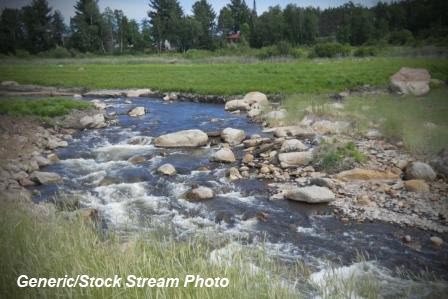
6.74 Miles
0 - 6.74
Cool-Cold Mainstem, Macroinvertebrate, Cool-Cold Headwater, Coldwater
2023
Excellent
Crawford
Yes
No
No
Fish and Aquatic Life
Overview
Picatee Creek flows approximately 6 miles west toward the Mississippi River. It drains steep forested hills with agriculture in the valleys and ridgetops. Picatee Creek is now a Coldwater Class I Trout Stream (2008 listing update). Surveys in 2002, 2005 indicated successful reproduction. A fishery survey conducted in 2000 documented only brook stickleback, a forage species. Low water volumes and small stagnant pools were documented in a middle reach of the stream. The lower end of Picatee Creek likely contains warm water species from the Mississippi River. Subsequent surveys in 2002 and 2005 indicated successful trout reproduction. A small portion of the lower end of the creek flows through land owned by the Wisconsin DNR.
Date 2010
Author Cynthia Koperski
Condition
Wisconsin has over 84,000 miles of streams, 15,000 lakes and milllions of acres of wetlands. Assessing the condition of this vast amount of water is challenging. The state's water monitoring program uses a media-based, cross-program approach to analyze water condition. An updated monitoring strategy (2015-2020) is now available. Compliance with Clean Water Act fishable, swimmable standards are located in the Executive Summary of Water Condition in 2018. See also the 'monitoring and projects' tab.
Reports
Recommendations
Monitor Baseline Survey
Picatee Creek is classified as Class I Trout water in 2008. No bug data on file; FIBI baseline data poor (2000) but stocking survey showed "good" quality (2002). Gather bug data when possible to confirm condition.
Management Goals
Wisconsin's Water Quality Standards provide qualitative and quantitative goals for waters that are protective of Fishable, Swimmable conditions [Learn more]. Waters that do not meet water quality standards are considered impaired and restoration actions are planned and carried out until the water is once again fishable and swimmable
Management goals can include creation or implementation of a Total Maximum Daily Load analysis, a Nine Key Element Plan, or other restoration work, education and outreach and more. If specific recommendations exist for this water, they will be displayed below online.
Monitoring
Monitoring the condition of a river, stream, or lake includes gathering physical, chemical, biological, and habitat data. Comprehensive studies often gather all these parameters in great detail, while lighter assessment events will involve sampling physical, chemical and biological data such as macroinvertebrates. Aquatic macroinvertebrates and fish communities integrate watershed or catchment condition, providing great insight into overall ecosystem health. Chemical and habitat parameters tell researchers more about human induced problems including contaminated runoff, point source dischargers, or habitat issues that foster or limit the potential of aquatic communities to thrive in a given area. Wisconsin's Water Monitoring Strategy was recenty updated.
Grants and Management Projects
Monitoring Projects
| WBIC | Official Waterbody Name | Station ID | Station Name | Earliest Fieldwork Date | Latest Fieldwork Date | View Station | View Data |
|---|
| 1634700 | Picatee Creek | 10058577 | Picatte Creek, Hwy 35 | 11/1/2023 | 11/1/2023 | Map | Data |
| 1634700 | Picatee Creek | 10013688 | Picatee Creek 2004-Ne 1/4 Sw 1/4 Sec. 30-Starts At Driveway On Dick Mcnutt Property. | 8/4/2011 | 1/1/2015 | Map | Data |
| 1634700 | Picatee Creek | 10056917 | Picatee Cr- Picatee Creek Rd 0.5mi US of STH 35 | | | Map | Data |
| 1634700 | Picatee Creek | 10008948 | Picatee Creek #1 - Road Crossing On Nicholson'S Property In Nese Of Section | | | Map | Data |
| 1634700 | Picatee Creek | 10013481 | Picatee Creek St. 1 - Pool Area Below Crossing On Nicholson Property | | | Map | Data |
|

Watershed Characteristics
Picatee Creek is located in the Rush Creek watershed which is 240.16 mi². Land use in the watershed is primarily forest (46.60%), grassland (16.20%) and a mix of agricultural (15%) and other uses (22.10%). This watershed has 551.06 stream miles, 1,906.88 lake acres and 9,793.93 wetland acres.
Nonpoint Source Characteristics
This watershed is ranked High for runoff impacts on streams, Not Ranked for runoff impacts on lakes and Medium for runoff impacts on groundwater and therefore has an overall rank of Medium. This value can be used in ranking the watershed or individual waterbodies for grant funding under state and county programs.However, all waters are affected by diffuse pollutant sources regardless of initial water quality. Applications for specific runoff projects under state or county grant programs may be pursued. For more information, go to surface water program grants.
Picatee Creek is considered a Cool-Cold Mainstem, Macroinvertebrate, Cool-Cold Headwater, Coldwater under the state's Natural Community Determinations.
Natural communities (stream and lake natural communities) represent model results and DNR staff valiation processes that confirm or update predicted conditions based on flow and temperature modeling from historic and current landscape features and related variables. Predicated flow and temperatures for waters are associated predicated fish assemblages (communities). Biologists evaluate the model results against current survey data to determine if the modeled results are corect and whether biological indicators show water quaity degradation. This analysis is a core component of the state's resource management framework. Wisconsin's Riverine Natural Communities.
Cool (Cold-Transition) Mainstem streams are moderate-to-large but still wadeable perennial streams with cold to cool summer temperatures. Coldwater fishes are common to uncommon, transitional fishes are abundant to common, and warm water fishes are uncommon to absent. Headwater species are common to absent,
mainstem species are abundant to common, and river species are common to absent.
Cool (Cold-Transition) Headwaters are small, usually perennial streams with cold to cool summer temperatures. Coldwater fishes are common to uncommon (<10 per 100 m), transitional fishes are abundant to common, and warm water fishes are uncommon to absent. Headwater species are abundant to common, mainstem species are common to absent, and river species are absent.
More Interactive Maps
Maps of Watershed